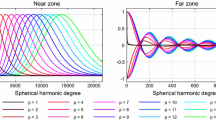Abstract
Airborne gravity data is usually attached with satellite positioning of data points, which allow for the direct determination of the gravity disturbance at flight level. Assuming a suitable gridding of such data, Hotine’s modified integral formula can be combined with an Earth Gravity Model for the computation of the disturbing potential (T) at flight level. Based on T and the gravity disturbance data, we directly downward continue T to the geoid, and we present the final solution for the geoid height, including topographic corrections. It can be proved that the Taylor expansion of T converges if the flight level is at least twice the height of the topography, and the terrain potential will not contribute to the topographic correction. Hence, the simple topographic bias of the Bouguer shell yields the only topographic correction. Some numerical results demonstrate the technique used for downward continuation and topographic correction.
Similar content being viewed by others
References
Alberts B. and Klees R., 2004. A comparison of methods for the inversion of airborne gravity data. J. Geodesy, 78, 55–65, doi: 10.1007/s00190-003-0366-x.
Bartle R.G., 1964. The Elements of Real Analysis. J Wiley and Sons, Inc., New York, London, Sydney.
Eshagh M. and Sjöberg L.E., 2009. Impact of topographic and atmospheric masses over Iran on validiation and inversion of GOCE gradiometric data. J. Earth Space Phys., 34, 15–18.
Forsberg R. and Kenyon S., 1994. Evaluation and downward continuation of airborne gravity data-the Greenland example. In: Proceedings of International Symposium on Kinematic Systems in Geodesy, Geomatics and Navigation (KIS94), Banff, Canada, August 30–September 2, 531–538.
Forsberg R., Olesen A., Bastos L. Gidskehaug A. Meyer U. and Timmen L., 2000. Airborne geoid determination. Earth Planet Spaces, 52, 863–866.
Forsberg R., 2003. Downward continuation of airborne gravity data. In; Tziavos I.N. (Ed.), Gravity and Geoid 2002, 3rd Meeting of the International Gravity and Geoid Commission, Thessaloniki 2002, 51–56, Ziti Editions, Thessaloniki, Greece, ISBN: 960-431-852-7.
Heiskanen W.A. and Moritz H., 1967. Physical Geodesy. W. H. Freeman and Co., San Francisco and London.
Hwang C., Hsiao Y.S. and Shih H.C., 2006. Data reduction in scalar airborne gravimetry: Theory, software and case study in Taiwan. Comput. Geosci., 32, 1573–1584, doi: 10.1016/j.cageo.2006.02.015.
Jekeli C., 1979. Global Accuracy Estimates of Point and Mean Undulation Differences Obtained from Gravity Disturbances Gravity Anomalies and Potential Coefficients. Report No.288, Dept. Geod. Sci., The Ohio State University, Columbus, OH.
Jekeli C., 1987. The downward continuation of aerial gravimetric data without density hypothesis, Bulletin Geodesique, 61, 319–329.
Jekeli C., 2001. Inertial Navigation Systems with Geodetic Applications. Walter de Gruyter, Berlin, New York.
Novák P., 2003. Optimal model for geoid determination from airborne gravimetry. Stud. Geophys. Geod., 47, 1–36.
Serpas J.G. and Jekeli C., 2005. Local geoid determination from airborne vector gravimetry. J. Geodesy,78, 577–587, doi: 10.1007/s00190-004-0416-z.
Sjöberg L.E., 1987. The modification of Stokes’ and Hotine’s formulas-a comparison. In: Holota P. (Ed.), Proceedings of the International Symposium on Figure and Dynamics of the Earth, Moon and Planets. Astronomical Institute of the Czechoslovak Academy of Sciences and Research Institute of Geodesy and Topography, Prague, Czech Republic, 268–278.
Sjöberg L.E., 1991. Refined least squares modification of Stokes’ formula. Manuscripta Geodaetica, 16, 367–375.
Sjöberg L.E., 2003. A general model of modifying Stokes’ formula and its least squares solution. J. Geodesy, 77, 459–464.
Sjöberg. L.E., 2007. The topographic bias by analytical continuation in physical geodesy. J. Geodesy, 81, 345–350.
Sjöberg L.E. 2009. The terrain correction in gravimetric geoid determination-is it needed? Geophys. J. Int., 176, 14–18.
Tenzer R. and Novák P., 2008. Conditionality of inverse solutions to discretised integral equations in geoid modelling from local gravity data. Stud. Geophys. Geod., 52, 53–70.
Tscherning C.C., Rubek F. and Forsberg R., 1997. Combining airborne and ground gravity using collocation. In: Forsberg R., Feissl M. and Dietrich R. (Eds.), Geodesy on the Move. International Association of Geodesy Symposia, 119, Springer-Verlag, Berlin, 18–23.
Vaníčcek P., Changyou Z. and Sjöberg L.E., 1992. A comparison of Stokes’s and Hotine’s approaches to geoid computation. Manuscripta Geodaetica, 17, 29–35.
Wang Y.M., 1990. The Role of the Topography in Gravity Gradiometer Reductions and in the Solution of the Geodetic Boundary Value Problem Using Analytical Downward Continuation. Report No.405, Dept. Geod. Sci. and Surv., The Ohio State University, Columbus, OH.
Wenzel H.G., 1998. Ultra-high degree geopotential models GPM98A, B, and C to degree 1800. Proceedings of the 2nd Joint Meeting of the International Gravity Commission and International Geoid Commission, September 7–12, Trieste, Italy, Bulletin of International Geoid Service, Milan, Italy.
Wieczorek M.A., 2007. The gravity and topography of the terrestrial planets. In: Spohn T. (Ed.), Volume 10 — Planets and Moons, 165–206, of Schubert G. (Ed.-in-Chief), Treatise on Geophysics, Elsevier, Amsterdam, The Netherlands..
Author information
Authors and Affiliations
Corresponding author
Rights and permissions
About this article
Cite this article
Sjöberg, L.E., Eshagh, M. A geoid solution for airborne gravity data. Stud Geophys Geod 53, 359–374 (2009). https://doi.org/10.1007/s11200-009-0025-7
Received:
Revised:
Accepted:
Published:
Issue Date:
DOI: https://doi.org/10.1007/s11200-009-0025-7




